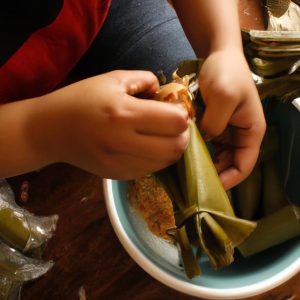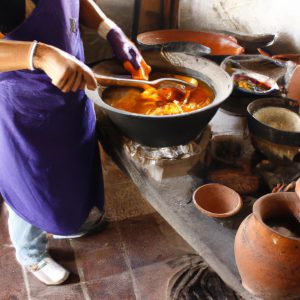Oregano, a versatile herb known for its distinct aroma and flavor, plays an essential role in Mexican cuisine. With its origins rooted in the Mediterranean region, oregano has found its way into various culinary traditions around the world. In Mexican gastronomy, oregano is used not only as a seasoning but also as a medicinal herb due to its potential health benefits. This article aims to explore the significance of oregano in Mexican cuisine, shedding light on its various uses and providing insights into how it contributes to the overall taste profile of traditional Mexican dishes.
To illustrate the importance of oregano in Mexican cooking, let us consider the classic dish of enchiladas verdes. These mouthwatering tortillas filled with shredded chicken or cheese are bathed in a vibrant green sauce made primarily from tomatillos, onions, garlic, and chili peppers. However, what truly sets this dish apart is the addition of dried oregano during the preparation process. The earthy and slightly peppery notes of oregano complement the tanginess of tomatillos while adding depth and complexity to the overall flavor profile. Without this key ingredient, enchiladas verdes would lack their characteristic aromatic essence that captivates both locals and visitors alike , making oregano an indispensable component of this beloved Mexican dish.
In addition to enchiladas verdes, oregano is also commonly used in other Mexican staples such as salsa, mole, and pozole. Its distinct flavor enhances the taste of these dishes by providing a balance of herbal and savory notes. Oregano can be added either in its fresh or dried form, depending on the desired intensity of flavor. While fresh oregano delivers a more vibrant and pungent taste, dried oregano offers a mellower profile that blends harmoniously with the other ingredients.
Apart from its culinary applications, oregano holds medicinal properties that have been valued for centuries. In traditional Mexican medicine, it is often used as a natural remedy for digestive issues, respiratory conditions, and even skin problems. The herb contains compounds like carvacrol and thymol, which are believed to possess antimicrobial and antioxidant properties. As a result, oregano has gained recognition not only as a flavorful herb but also as a potential aid in improving overall health.
When incorporating oregano into your Mexican dishes, it is important to note that different varieties exist. Mexican oregano (Lippia graveolens) is the most common type used in Mexican cuisine due to its robust flavor profile and similarity to Mediterranean oregano (Origanum vulgare). However, there are subtle differences between the two in terms of taste and aroma. It is advisable to experiment with both types to find your preferred choice based on personal preference and the specific dish you are preparing.
Overall, oregano plays a significant role in Mexican cuisine by imparting its delightful fragrance and adding layers of flavor complexity. Whether it’s enhancing the tanginess of tomatillos or providing medicinal benefits, this versatile herb continues to captivate the palates of food enthusiasts worldwide. So next time you savor a plate of enchiladas verdes or any other traditional Mexican dish, take a moment to appreciate the unique contribution of oregano that elevates the culinary experience.
Oregano: A Staple Herb in Mexican Cooking
Imagine walking into a traditional Mexican kitchen, filled with the aroma of various herbs and spices. Among them, oregano stands out as a staple herb used extensively in Mexican cuisine. Whether it’s sprinkled onto tacos, incorporated into salsas, or added to marinades for meats, oregano plays an integral role in enhancing the flavors of authentic Mexican dishes.
Oregano’s popularity in Mexico can be attributed to its versatility and unique taste profile. Its distinct flavor is often described as earthy, slightly bitter, and peppery, adding depth and complexity to different recipes. Used both dried and fresh, this herb has become synonymous with the vibrant flavors that characterize Mexican cooking traditions.
To showcase the significance of oregano in Mexican cuisine, let us consider some key points:
- Cultural Significance: Oregano holds cultural significance in Mexico due to its historical use by indigenous communities. It has been utilized not only for culinary purposes but also for medicinal and spiritual practices.
- Enhancing Traditional Recipes: Oregano serves as a fundamental ingredient in many classic Mexican dishes such as mole sauces, enchiladas, and pozole. Its robust flavor helps balance other ingredients while imparting an unmistakable essence specific to Mexican gastronomy.
- Regional Variations: Different regions within Mexico have their own variations of using oregano. For instance, Yucatan-style cochinita pibil incorporates achiote paste along with oregano to create a distinctive flavor profile representative of that area’s culinary heritage.
- Health Benefits: Apart from its culinary uses, oregano also offers health benefits due to its antioxidant properties and potential antibacterial effects. Research suggests that certain compounds found in oregano may possess antimicrobial properties against common pathogens.
As we delve deeper into the fascinating world of oregano in Mexican cuisine, the subsequent section will explore the different types of oregano commonly used in traditional Mexican cooking. By understanding these variations, we can gain a deeper appreciation for the nuanced flavors and cultural significance that make Mexican cuisine so beloved around the world.
Different Types of Oregano Used in Mexican Cuisine
Oregano: A Versatile Herb in Mexican Cuisine
Imagine the aroma of a sizzling pan, as seasoned pork chops are being prepared for a traditional Mexican dish. The tantalizing scent of oregano fills the air, infusing each bite with its distinct flavor. Oregano is not only a staple herb but also an essential component in many authentic Mexican recipes. In this section, we will explore the different types of oregano used in Mexican cuisine and their unique characteristics.
When it comes to oregano varieties commonly found in Mexico, three main types stand out:
- Mexican Oregano: This variety is native to Mexico and possesses a slightly citrusy and earthy flavor profile. It is often described as having hints of mild licorice or mint undertones.
- Greek Oregano: Greek oregano, although not indigenous to Mexico, has become popular due to its robust taste that can withstand high temperatures during cooking. Its strong peppery notes add depth and complexity to various dishes.
- Italian Oregano: Italian oregano boasts a delicate yet distinctive aromatic quality that enhances the flavors of Mediterranean-inspired Mexican meals such as pizzas or pasta dishes.
To further appreciate the significance of oregano in Mexican cuisine, let us consider some notable aspects about this versatile herb:
- Oregano contains antioxidants that contribute to its potential health benefits, including reducing inflammation and boosting immune function.
- Its antimicrobial properties make it useful for preserving food when added during cooking or drying processes.
- Rich in vitamins A, C, K, and fiber content, oregano adds nutritional value without significantly increasing caloric intake.
- Incorporating dried or fresh oregano into your diet may aid digestion by stimulating bile flow and promoting optimal gastrointestinal functioning.
Now that we have explored the diverse range of oregano varieties available in Mexican cuisine and highlighted some intriguing attributes of this herb, let us delve into its culinary uses in traditional Mexican dishes. By doing so, we will uncover the myriad ways oregano elevates the flavors and authenticity of Mexican gastronomy.
Culinary Uses of Oregano in Mexican Dishes
Exploring the Flavor Profile of Different Types of Oregano
Imagine yourself walking into a bustling Mexican restaurant, as enticing aromas waft through the air. You order your favorite dish, and when it arrives at your table, you notice that its vibrant flavors are enhanced by a distinct herbaceous note. This delightful flavor can be attributed to none other than oregano – an essential spice in Mexican cuisine. In this section, we will delve deeper into the various types of oregano used in Mexican cooking, revealing their unique characteristics and contributions to culinary masterpieces.
When it comes to oregano varieties employed in Mexican dishes, there is no shortage of options. Each type possesses its own distinctive aroma and taste profile, elevating different dishes in diverse ways. Here are some notable examples:
-
Mexican Oregano (Lippia Graveolens): This variety is native to Mexico and Central America and boasts a robust flavor with citrus undertones. Its intense aroma makes it particularly suitable for use in salsas, marinades, and meat rubs.
-
Mediterranean Oregano (Origanum Vulgare): Widely recognized as the classic oregano found in Italian cuisine, Mediterranean oregano has also found its way into Mexican recipes. It offers a milder yet earthy flavor that pairs well with tomato-based sauces, beans, and stews.
-
Thymus Capitatus: Also known as Spanish thyme or Cuban oregano, this variety brings a hint of spiciness along with floral notes reminiscent of thyme and mint. Its assertive taste profile complements grilled meats and hearty soups splendidly.
-
Epazote (Dysphania Ambrosioides): Though not technically an oregano species per se, epazote is widely used alongside traditional oregano in Mexican cuisine. With its pungent, almost gasoline-like fragrance and distinctively sharp taste, it is a key ingredient in bean dishes like frijoles de la olla.
To truly appreciate the flavorful impact of different types of oregano on Mexican cuisine, consider the following sensory experience:
- Close your eyes and imagine the alluring aroma of freshly crushed Mexican oregano mingling with tangy lime juice as you prepare a zesty salsa.
- Picture yourself savoring slow-cooked beef birria, enriched by the earthiness of Mediterranean oregano that harmonizes beautifully with the richness of tender meat.
- Envision biting into a succulent grilled chicken thigh marinated with Spanish thyme, enjoying the infusion of spicy and minty flavors that dance tantalizingly on your palate.
- And finally, envision indulging in a comforting bowl of black beans flavored with both traditional oregano and epazote, relishing their combined essence that elevates this humble dish to new heights.
As we have learned about the diverse array of oregano varieties used in Mexican cuisine and explored their flavor profiles through vivid descriptions, let us now turn our attention to another aspect: the health benefits associated with incorporating oregano into Mexican cooking.
Health Benefits of Oregano in Mexican Cooking
In the previous section, we explored the various ways oregano is used in Mexican cuisine. Now, let’s delve deeper into its culinary applications and discover how this versatile herb enhances the flavors of traditional Mexican dishes.
To illustrate the impact of oregano on Mexican cooking, let’s consider a hypothetical case study: Maria, an experienced home cook, decides to prepare her family’s favorite dish, enchiladas verdes. She gathers all the necessary ingredients – chicken, tortillas, tomatillos, onions, garlic – but it is the addition of oregano that truly elevates the dish. By sprinkling just a pinch of dried oregano over the sauce simmering on the stove, Maria imparts a distinct earthy aroma and robust flavor that perfectly complements the tanginess of the tomatillos.
When it comes to using oregano in Mexican cuisine, here are some key points to keep in mind:
- Dried vs. Fresh: Both dried and fresh oregano can be used in Mexican dishes; however, they have different characteristics. Dried oregano tends to be more potent and has a stronger flavor profile compared to its fresh counterpart.
- Pairings with Other Spices: Oregano often works harmoniously with other spices commonly found in Mexican cuisine such as cumin, chili powder, and paprika. This combination creates complex layers of flavor that enhance dishes like mole poblano or carne asada.
- Balance between Heat and Herbaceousness: Oregano can help balance out spicy ingredients by providing a cooling effect on the palate while adding depth to the overall taste profile.
- Versatility across Different Cuisines: Although we are focusing on its use in Mexican cooking here, it is worth noting that oregano also plays a significant role in other global cuisines such as Italian and Mediterranean.
To further illustrate the versatility of oregano in Mexican cuisine, consider the following table that showcases some popular dishes where oregano is a key ingredient:
| Dish | Description |
|---|---|
| Pozole | A traditional Mexican soup made with hominy corn, meat (usually pork), and flavored with oregano. |
| Chiles Rellenos | Roasted or fried peppers stuffed with cheese or meat, often seasoned with oregano-infused sauces. |
| Tacos al Pastor | Marinated pork cooked on a vertical spit, typically served in tortillas topped with fresh oregano. |
| Salsa Verde | A tangy green sauce made from tomatillos, cilantro, onions, garlic, lime juice, and dried oregano. |
As we can see from this diverse range of dishes, oregano not only adds depth and complexity to the flavors but also brings an unmistakable touch of authenticity to Mexican cuisine.
So let’s turn our attention now to “Oregano vs. Other Mexican Herbs: A Comparison. “.
Oregano vs. Other Mexican Herbs: A Comparison
Imagine you are preparing a traditional Mexican dish, and the recipe calls for oregano. But what if you don’t have any on hand? Are there other herbs that can be used as a substitute? In this section, we will explore how oregano compares to other popular Mexican herbs in terms of flavor profiles, culinary uses, and availability.
Let’s start by considering cilantro, one of the most commonly used herbs in Mexican cuisine. While both cilantro and oregano share their origins in the Mediterranean region, they exhibit distinct flavors. Cilantro offers a fresh and citrusy taste with hints of parsley, making it ideal for adding brightness to salsas or garnishing tacos. On the other hand, oregano brings an earthy and slightly bitter note to dishes like mole sauces or hearty stews.
Moving beyond cilantro, another herb worth exploring is epazote. Epazote has a unique aroma reminiscent of licorice combined with strong herbal notes. This herb is often used in bean-based dishes due to its ability to reduce gas-inducing properties while imparting a distinctive flavor profile. However, when compared to oregano’s versatility across various recipes such as enchiladas or tamales, epazote tends to have more limited applications.
Next up is hierba santa (holy leaf), which boasts large heart-shaped leaves with fragrant qualities akin to black pepper mixed with eucalyptus. Traditionally used in wrapping tamales or fish fillets before grilling them over open flames, hierba santa provides a subtle yet complex flavor that complements seafood exceptionally well. Nonetheless, its specific taste may not lend itself as seamlessly to diverse dishes as oregano does.
Lastly, we have hoja santa (Mexican pepperleaf) – an herb known for its vibrant green color and anise-like scent. Hoja santa leaves are often used in traditional Mexican soups, imparting a unique herbal taste that enhances the overall flavor profile of the dish. However, when compared to oregano’s widespread availability and compatibility with various cooking techniques, hoja santa may be harder to find and less versatile.
To summarize the comparisons between oregano and other Mexican herbs:
- Oregano: Earthy and slightly bitter; versatile for use in sauces and stews.
- Cilantro: Fresh and citrusy; excellent as a garnish or in salsas.
- Epazote: Licorice-like aroma; complements bean-based dishes but has limited applications.
- Hierba Santa: Peppery with eucalyptus notes; pairs well with seafood but may not suit all recipes.
- Hoja Santa: Anise-like scent; ideal for enhancing flavors in soups, though it may be more challenging to find.
Now that we have explored the distinct characteristics of these herbs, let’s move on to the next section where we will provide you with some valuable tips for using oregano effectively in your Mexican recipes.
Tips for Using Oregano in Mexican Recipes
As we delve deeper into the world of oregano and its role in Mexican cuisine, it is essential to explore its medicinal properties. While many people associate herbs primarily with flavoring dishes, oregano offers a range of health benefits that have been utilized for centuries. To better understand this aspect, let us consider a hypothetical scenario:
Imagine Maria, a young woman living in Mexico City who frequently experiences digestive discomfort after meals. Seeking a natural remedy, she turns to oregano tea as recommended by her grandmother. After incorporating the herbal infusion into her routine, Maria notices an improvement in her digestion and overall well-being.
Oregano’s healing properties can be attributed to its rich composition of compounds such as carvacrol, thymol, and rosmarinic acid. These bioactive components possess antimicrobial and antioxidant effects that contribute to various health advantages when consumed regularly. Let us explore some key therapeutic qualities associated with oregano:
-
Anti-inflammatory Benefits:
- Oregano contains powerful anti-inflammatory compounds that may help alleviate symptoms related to inflammatory conditions such as arthritis or asthma.
- Research suggests that these beneficial effects could result from the inhibition of specific enzymes responsible for triggering inflammation.
-
Digestive Aid:
- The consumption of oregano has been linked to improved digestion due to its ability to increase bile production.
- This herb may also support gut health by reducing harmful bacteria while promoting the growth of beneficial flora.
-
Immune System Support:
- Oregano exhibits immune-enhancing properties owing to its high concentration of antioxidants.
- Studies indicate that these antioxidants can stimulate white blood cell activity and protect against oxidative stress.
-
Respiratory Health Promotion:
- Inhalation or ingestion of oregano oil vapor may assist in relieving respiratory ailments like coughs or congestion.
- Its expectorant properties can help expel mucus and ease breathing difficulties.
To further illustrate the therapeutic benefits of oregano, let us consider a comparative analysis of its medicinal qualities alongside other commonly used herbs in Mexican cuisine. The table below presents an overview:
| Herb | Medicinal Properties |
|---|---|
| Oregano | Anti-inflammatory, Digestive Aid |
| Cilantro | Detoxification, Antioxidant |
| Epazote | Gas Relief, Digestive Aid |
| Achiote seeds | Antibacterial, Anti-inflammatory |
In conclusion, while oregano is renowned for its culinary contributions to Mexican dishes, it also offers numerous health advantages. Its anti-inflammatory properties, digestive aid capabilities, immune system support, and respiratory health promotion make it a valuable addition to any diet. By incorporating this versatile herb into their meals or exploring alternative methods such as herbal infusions or essential oils, individuals like Maria may experience not only enhanced flavor but also improved well-being.











More Stories
Chili Powder: A Key Ingredient for Mexican Food Spices and Seasonings
The Flavors: Spices and Seasonings in Mexican Cuisine
Cumin: A Fundamental Mexican Spice